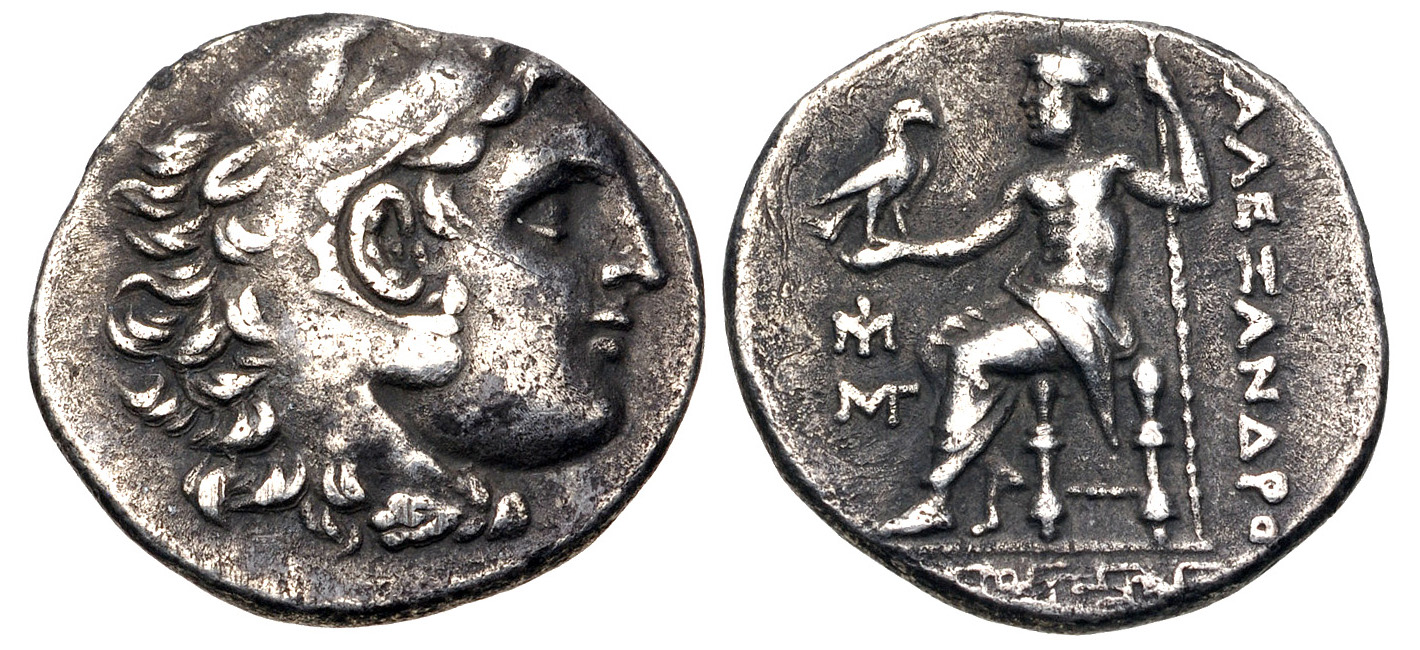S 1666 - Magnesia ad Maeandrum (types of Alexander the Great), silver, drachms (225-200 BCE)
From SILVER
225 BCE - 200 BCE Silver 451 kg
Description
| ObverseInscription or printing placed on the obverse.: | Head of Herakles right, wearing lion skin |
| ReverseInscription or printing placed on the reverse.: | AΛΕΞΑΝΔPOY (Greek).Zeus Aëtophoros seated left, two monograms in left field, maeander pattern in exergue |
Mint and issuing power
| MintIdentifies the place of manufacture or issue of a numismatic object.: | Magnesia ad Maeandrum | Ancient regionAncient region.: | Ionia | Modern countryModern country: Turkey | AuthorityIdentifies the issuing power. The authority can be "pretended" when the name or the portrait of X is on the coin but he/she was not the issuing power. It can also be "uncertain" when there is no mention of X on the coin but he/she was the issuing power according to the historical sources: | Alexander III the Great (Argead king, 336-323 BC) |
Chronology
| FromIdentifies the initial date in a range assigned in a numismatic context. | 225 BCE | toIdentifies the final date in a range assigned in a numismatic context.. | 200 BCE | PeriodTime period of the numismatic object.: Hellenistic 323-30 BC |
Physical description
| MetalThe physical material (usually metal) from which an object is made.: | Silver |
Median weightMedian of the weights of numismatic objects (in grams). in grams | 4.25 | DenominationTerm indicating the value of a numismatic object. Examples: tetradrachm, chalkous, denarius.: | drachma |
StandardStandard.: | Attic |
Image

S 1666 - Magnesia ad Maeandrum (types of Alexander the Great), silver, drachms (225-200 BCE).jpg [1]
References
| Die study referencePublication of the study: | Vădan 20181Vădan 2018, p. 102-103 (Group 2) | ||
| Coin series referenceReference to coin series study: | |||
Obverse dies distribution
| FrequencyFrequency of specimen in distribution. ᵖ | Number of obversesNumber of obverse dies. ᵖ (o) | % (o) | Number of coinsNumber of coins. (n) | % (n) | Die nameName(s) of the die(s). |
| 1 | 1 | 25 | 1 | 9.09 | 10 |
| 2 | 1 | 25 | 2 | 18.18 | 7 |
| 3 | 1 | 25 | 3 | 27.27 | 8 |
| 5 | 1 | 25 | 5 | 45.45 | 9 |
| Total | 4 of 4 | 100 | 11 of 11 | 99.99 |
Reverse dies distribution
no distribution is available
Quantification
| Number of obversesNumber of obverse dies. ᵖ (o) | 4 | Number of singletons (o1)The number of singleton coins. ᵖ | 1 |
| Number of reverse diesNumber of reverse dies. (r) | 9 | Number of coinsNumber of coins. (n) | 11 |
| Coins per obverse dieNumber of coins per obverse die. (n/o) | 2.75 | Coins per reverse dieNumber of coins per reverse die. (n/r) | 1.22 |
| Reverse per obverse ratioRatio of obverse dies divided by reverse dies. (r/o) | 2.25 | Percentage of singletons (o1)number of coins (n) divided by the number of singletons (o1) ᵖ | 25 % |
| Original number of dies (O) (Carter 1983 formula)The estimation of the number of coins according to Carter 1983 ᵖ | 5.3 | Coins struck if 20,000 as average productivity per dieCoins made if the average productivity for obverses (according to Carter) is 20,000. ᵖ | 106,000 |
| Original number of dies (O) (Esty 2011 formula)The estimation of the number of coins according to the singleton formula in Esty 2011 ᵖ (O) | 6.29 | Survival rate if 20,000 as average productivity per dieSurvival rate if average productivity is 20,000. ᵖ | 0.00010 |
| Coverage (o = % of O) (Esty 1984 formula)Esty 1984 - coverage (% of O) ᵖ (o = % of O) | 90.91% | Die productivity if survival rate 1/2,000Average productivity if survival rate is 1/2,000. ᵖ | 4,150.94 |
| Weight of silver (in kg) if 20,000 coins per die (O = Carter formula)Carter 1983 * Median weight * 20000 (*10 if gold or electrum) ᵖ | 451 kg <br /> 451 kg | Die productivity if survival rate 1/5,000Average productivity if survival rate is 1/5,000. ᵖ | 10,377.36 |
Remarks
Die study done by Philip Kinns
References
- ^ Vădan, Paul (2018), "The Posthumous Alexander Tetradrachms of Magnesia on the Maeander", American Journal of Numismatics, 30, p. 45-106.